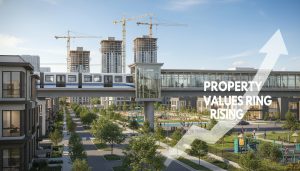Are there upcoming infrastructure projects that may affect
property value?
Will Upcoming Infrastructure Projects Boost Your Home Value? — The Truth Most Buyers Miss
Location wins. But not all infrastructure lifts property value. Some projects add demand and convenience. Others add noise, traffic, and delays. Know the difference and you control outcomes.
Why this matters now
Municipal governments and transit agencies are rolling out projects—light rail, subway extensions, new highways, major utility upgrades, schools, and parks. These change neighborhood economics. Studies show proximity to major transit or redevelopment often increases property values by roughly 5–20% over time. Timing, zoning, and design determine whether your street is a winner.
How infrastructure affects property value (fast checklist)
- Transit expansion (LRT, subway, commuter rail): increases demand within 500m–1km. Expect higher resale and rental rates.
- Road or highway projects: mixed. Better regional access can boost value; added traffic and noise can reduce desirability for nearby homes.
- New schools and parks: reliably positive. Families pay a premium for quality schools and green space.
- Zoning changes and planned density: high upside for investors if upzoning allows taller buildings, but may lower single-family appeal.
- Utilities and flood control: critical. Long-term property security beats short-term price swings.
Real example you can relate to
Transit corridors show clear patterns. In many North American cities, announced light-rail or subway extensions create a ripple: developers buy land, retail follows, and values rise along the corridor. Expect the biggest gains inside the first 500m from transit hubs.
Red flags that cut value
- Ongoing heavy construction with unknown completion dates.
- Permanent loss of privacy or green buffer replaced by high-density towers.
- Increased traffic flow through residential streets.
- Poorly planned noise mitigation.
What to do right now — a four-step action plan
- Check official municipal planning portals. Look for master plans, environmental assessments, and public consultation schedules.
- Attend or review minutes from community consultations. Timelines and project scope matter more than headlines.
- Consult property-level impact: distance, sight lines, noise studies, zoning. Use 500m–1km as a starting radius for transit projects.
- Get a professional local market analysis. A realtor who tracks planning files can quantify upside and downside.
Why work with a local expert
You need someone who reads planning reports and translates them into dollars and timelines. I monitor municipal approvals, zoning changes, and transit announcements in our region. That expertise turns uncertainty into advantage.
Ready to evaluate a specific property or neighborhood? I’ll run a targeted infrastructure impact report — timeline, upside estimate, risks, and tactical buying advice.
Contact me: Tony Sousa, Local Realtor
Email: tony@sousasells.ca | Phone: 416-477-2620
Website: https://www.sousasells.ca
Act now. Know the projects, know the timeline, and buy with confidence.





















